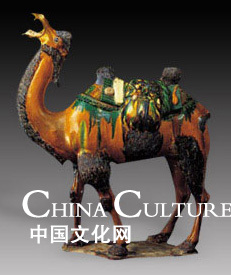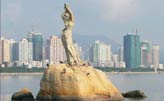Specials
Mysterious pottery
Updated: 2008-07-31 13:53
By Wang Nan (chinaculture.org)
 |
|
|
In the early period of the 20th century, Longhai railway was built through the Mang mountains, north of Luoyang city, Henan Province, where the graveyards of the Han and Tang dynasties were located. When these tombs were excavated, lots of colorful pottery was found. However, the find did not received much attention from the media or public at the time. Collectors thought they were just common funeral objects and were ill-boding, until a Chinese antiquities collector, Luo Zhenyu (1866 - 1940) saw their chips in a market.
To Luo’s surprise, there was no information about this kind of pottery in historical records. While experts were puzzling over these objects, they were named “Tang tri-colored glazed pottery” among the people.
 |
|
|
Tang tri-colored glazed pottery was very popular in the Tang Dynasty (618-907). It is a low-melting glazed pottery that is made by adding metallic oxides to the colored glaze and calcifying the object to create different colors, namely the predominant red, white and green.
The chemicals in the glaze change gradually in the firing process, creating a variegated effect with a majestic and elegant artistic attraction.
 |
|
|
Tri-colored glazed pottery utensils of the Tang Dynasty were usually rounded and full in shape in accordance with the aesthetic values of the time. The accurately proportioned human and animal figures have fluid lines, natural expressions and life-like movements, with the soldier figures having strong muscles and big staring eyes while wielding swords or arrows. The female figures have high hair buns and full sleeves; they stand gracefully erect, looking natural and elegant. The animal figures are mainly of horses and camels.
Tri-colored glazed pottery of the Tang Dynasty was mostly produced in Xi'an, Luoyang and Yangzhou, which were important cities along the Silk Road, with the camel as the major form of transport at the time. From these glazed potteries, we can imagine the travelers and camels making their hard journey across the desert, depending on one another for survival. The large figures and camels' resolute expressions represent the hardships associated with traveling on the long road.
|
|
 |
|
|
Tri-colored glazed pottery was exported to foreign countries early in the Tang Dynasty, winning great favour. It was always been famed for its bright colors and pleasing shapes And is a shining pearl among ancient Chinese pottery.
This type of pottery was usually used as for burial objects since its loose and brittle base, and low waterproofing properties meant it was not as practical as the blue and white porcelain that had already emerged at the time.

Specials

Jewel of the south
Zhuhai in South China has a wealth of natural allure that is open for business.

China in vogue
How Country captured the fascination of the world's most powerful fashion player

More than just a game
Mahjong is a deep-rooted cultural tradition that touches every level of society
